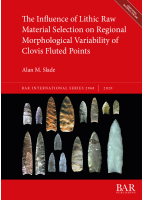Description
Clovis was once considered to be the first universal lithic technology to evolve in North America, occurring between 11,050 to 10,800 radiocarbon years before present (14C yr BP). These early hunter-gatherers left behind a sparse material record of their occupation that consists primarily of stone tools and the manufacturing debris associated with their production. The trademark tool of this earliest lithic technology to evolve in North America is a fluted point named after its type site discovery in a quarry at Blackwater Draw Locality No. 1, near Clovis, a town in New Mexico. These artefacts were made by widely separated groups throughout North America. The fluted points from Nova Scotia are much the same as those from New Mexico, not identical, but the similarities outweigh the differences. Not only are the fluted points similar across North America, but other technological aspects of the Clovis culture, i.e. blades, unifacial tools, and osseous tools, appear to be equally similar and widespread. In this study, the author identifies a number of Clovis and Clovis variants from seven environmentally different regions across North America. This monograph analyses the variability of Clovis fluted points and the lithic raw materials that they were produced on from a continental perspective. Complementing the research is a digital photographic dataset of the Clovis fluted points discussed, available online.
AUTHOR
Alan M. Slade is a postdoctoral researcher with the University of Texas at Austin, Texas Archaeological Research Laboratory (TARL) and is also a team member of the Prehistory Research Project (PRP). Alan spent fifteen years as a Prehistoric and Palaeolithic field archaeologist in Britain and Europe, and a further decade helping to curate the lithic collections in the British Museum. He is a research fellow of the Centre for the Archaeology of Human Origins (CAHO) at the University of Southampton; on the committee for the Lithic Studies Society (LSS); and he is also an active member of the Society for Museum Archaeologists (SMA).
REVIEW
‘This work contributes significant new knowledge to the field of research as a specific demonstration of how raw material characteristics can influence technological and stylistic aspects of stone tool production.’ Dr Michael B. Collins, Gault School of Archaeological Research and the Texas Archaeological Research Laboratory at the University of Texas, Austin











